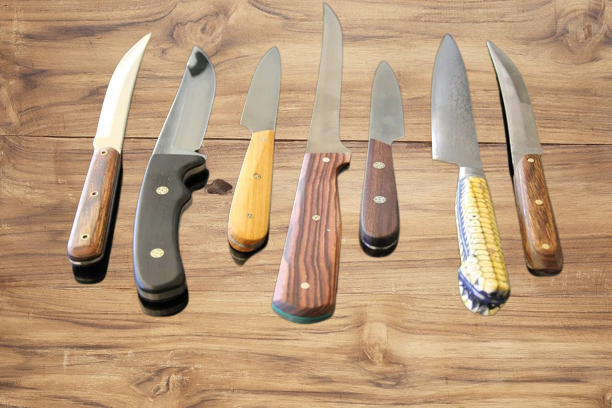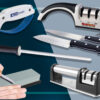Using Resorcinol glue, Epoxy resin, Micarta, or Wood as a stabilizing bone for knife handles is the standard method for restoring knives. But what if you’d like to make your own handle? Read on to learn about the benefits of these materials and how they can be used to repair a bone handle. We’ll also explore the pros and cons of each method. Ultimately, it’s all about personal preference.

Resorcinol glue
A good handle material is Resorcinol glue it is a durable industrial adhesive that keeps things together even in wet and dry conditions. Its high strength allows it to withstand high temperatures and has a very low water absorption rate. This glue is also highly resistant to corrosive conditions, such as saltwater and abrasion.
Manufactured from resorcinol, Resorcinol glue is a natural compound obtained by reacting a large amount of resin with potassium hydroxide. It has many medical uses, from surgery to cosmetic products. Because it’s so strong, resorcinol is an excellent choice for knife handles.
Epoxy resin handles
The process of stabilizing wood is an excellent way to protect your handle from wear and decay. It can also make softer woods hard enough for heavy use. Whether you’re making a knife handle for your own use or for selling, this process can help you make a great handle.

It takes just five simple steps: load the wood, saturate it with resin, cure it, and color it. Wood is the most common material for knife handles, but it is susceptible to change in temperature and humidity. For this reason, it can be difficult to manufacture knife handles with tight tolerances.
Although cow and giraffe bones are the most common types of bones used for handle materials, you can also find handles made from giraffe and elephant bone. These are both dense and add a sense of exoticism to your knife. Keep in mind, though, that bone handles can become porous over time, so it’s important to keep this in mind when deciding on the material for your handle. Luckily, there are a number of products on the market that are already stabilized and dyed with phenolic resin.
Knife Handle from Wood
When making a knife handle from wood, there are a couple of important considerations to consider. Wood needs to be stabilized before the knife maker can start crafting. First, wood handles need to be dried in a vacuum before applying resin. If the wood is solid and cool, it may be sufficient for a knife handle. If it isn’t, the next step will be applying a dye to the wood.

Another option for staining the bone is to use glue. Glutamate glue is a type of glue made from skin and bone material. It comes in liquid form and in hot glue granules. However, this type of glue is not waterproof. Alternatively, epoxy glue can be used. Epoxy glue is a transparent, gap-filling material that bonds the bones tightly together. It is particularly suitable for repairing tiny defects in the bone.
Micarta knife handle material
Micarta is a thermoplastic material created from layers of paper, linen, or canvas. Micarta is a registered trademark of Norplex-Micarta Industrial Plastics and is an excellent material for knife handles. Micarta is lightweight and resistant to abrasion and bending. It is also relatively indestructible. It is an excellent material for custom makers and is now also used on some production knives.

A thermoplastic grivory will outlast a blade, if properly maintained. It contains no metal whatsoever, so it should last for decades. It is also extremely strong and will most likely outlast the blade. Micarta is not a single material, but rather a composite of materials soaked in plastic. Micarta can be made from canvas, linen, carbon fiber, fiberglass, or paper.
Antlers are solid and stable
The use of antler is very common for knives. The antler crown has a central core that provides a very solid and stable surface for carving, inlaying gemstones, and other artwork. These antlers can be carved into belt buckles, conchos, and other pieces of jewelry. The antlers are quite resilient, so the use of them as knife handles doesn’t need any special care.

There are several different types of antler used for making knife handles. A good example of this material is that of the Sambar stag in India. While the Sambar antler has been banned for export for several years, the material remains a collector’s item. Traditional pocketknives have been made of this material. Other options include Micarta, which uses a resin-saturated substrate, and G-10, which uses a fiberglass substrate.
The post Stabilizing Bone For Knife Handles appeared first on KnifeGenie.com.
Using Resorcinol glue, Epoxy resin, Micarta, or Wood as a stabilizing bone for knife handles is the standard method for restoring knives. But what if you’d like to make your own handle? Read on to learn about the benefits of these materials and how they can be used to repair a bone handle. We’ll also explore the pros and cons of each method. Ultimately, it’s all about personal preference.

Resorcinol glue
A good handle material is Resorcinol glue it is a durable industrial adhesive that keeps things together even in wet and dry conditions. Its high strength allows it to withstand high temperatures and has a very low water absorption rate. This glue is also highly resistant to corrosive conditions, such as saltwater and abrasion.
Manufactured from resorcinol, Resorcinol glue is a natural compound obtained by reacting a large amount of resin with potassium hydroxide. It has many medical uses, from surgery to cosmetic products. Because it’s so strong, resorcinol is an excellent choice for knife handles.
Epoxy resin handles
The process of stabilizing wood is an excellent way to protect your handle from wear and decay. It can also make softer woods hard enough for heavy use. Whether you’re making a knife handle for your own use or for selling, this process can help you make a great handle.

It takes just five simple steps: load the wood, saturate it with resin, cure it, and color it. Wood is the most common material for knife handles, but it is susceptible to change in temperature and humidity. For this reason, it can be difficult to manufacture knife handles with tight tolerances.
Although cow and giraffe bones are the most common types of bones used for handle materials, you can also find handles made from giraffe and elephant bone. These are both dense and add a sense of exoticism to your knife. Keep in mind, though, that bone handles can become porous over time, so it’s important to keep this in mind when deciding on the material for your handle. Luckily, there are a number of products on the market that are already stabilized and dyed with phenolic resin.
Knife Handle from Wood
When making a knife handle from wood, there are a couple of important considerations to consider. Wood needs to be stabilized before the knife maker can start crafting. First, wood handles need to be dried in a vacuum before applying resin. If the wood is solid and cool, it may be sufficient for a knife handle. If it isn’t, the next step will be applying a dye to the wood.

Another option for staining the bone is to use glue. Glutamate glue is a type of glue made from skin and bone material. It comes in liquid form and in hot glue granules. However, this type of glue is not waterproof. Alternatively, epoxy glue can be used. Epoxy glue is a transparent, gap-filling material that bonds the bones tightly together. It is particularly suitable for repairing tiny defects in the bone.
Micarta knife handle material
Micarta is a thermoplastic material created from layers of paper, linen, or canvas. Micarta is a registered trademark of Norplex-Micarta Industrial Plastics and is an excellent material for knife handles. Micarta is lightweight and resistant to abrasion and bending. It is also relatively indestructible. It is an excellent material for custom makers and is now also used on some production knives.

A thermoplastic grivory will outlast a blade, if properly maintained. It contains no metal whatsoever, so it should last for decades. It is also extremely strong and will most likely outlast the blade. Micarta is not a single material, but rather a composite of materials soaked in plastic. Micarta can be made from canvas, linen, carbon fiber, fiberglass, or paper.
Antlers are solid and stable
The use of antler is very common for knives. The antler crown has a central core that provides a very solid and stable surface for carving, inlaying gemstones, and other artwork. These antlers can be carved into belt buckles, conchos, and other pieces of jewelry. The antlers are quite resilient, so the use of them as knife handles doesn’t need any special care.

There are several different types of antler used for making knife handles. A good example of this material is that of the Sambar stag in India. While the Sambar antler has been banned for export for several years, the material remains a collector’s item. Traditional pocketknives have been made of this material. Other options include Micarta, which uses a resin-saturated substrate, and G-10, which uses a fiberglass substrate.
![]()

